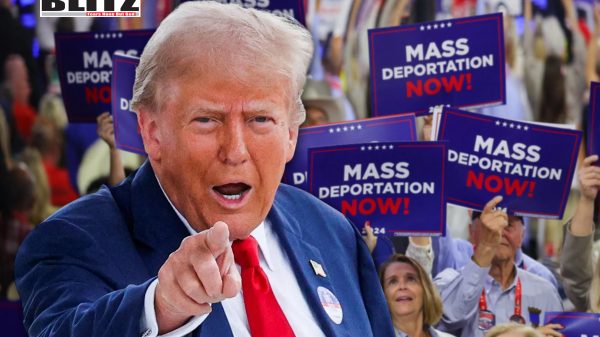Trump mass deportation plan and its impact on immigration
- Update Time : Monday, November 25, 2024

As President-elect Donald Trump prepares to take office in January, immigration policy is set to undergo a significant transformation. A central promise of Trump’s campaign was addressing what he described as the Biden Administration’s failure to control the border, a situation he claims has allowed millions of illegal immigrants to enter the United States. Trump’s proposed mass deportation plan has stirred debate across political and social circles, with supporters viewing it as a restoration of law and order, while critics argue it may lead to humanitarian and logistical challenges.
Under President Biden, the southern border faced what many described as a crisis, with over 10 million illegal crossings reported during his administration. While the precise number of undocumented immigrants currently in the US remains uncertain, estimates suggest the figure could range between 20 and 30 million. For Trump and his supporters, these numbers represent a failure of enforcement that demands immediate correction.
Trump’s campaign centered on reversing this trend through measures that would not only remove illegal immigrants but also deter further unauthorized entries. His decisive electoral victory, often interpreted as a mandate to act on this promise, has provided his administration with the political capital to pursue these policies aggressively.
Trump’s commitment to immigration enforcement became evident shortly after his election victory. He appointed Tom Homan, a former Acting Director of Immigration and Customs Enforcement (ICE) and Senior Fellow at the Immigration Reform Law Institute, as his “border czar.” Homan’s reputation as a hardliner on immigration enforcement signals that the administration intends to make good on its mass deportation pledge.
Initial reports suggest that Trump’s strategy will prioritize deporting undocumented immigrants with criminal records or outstanding removal orders. To carry out this ambitious plan, the administration has considered utilizing all available resources, including the military, to assist with enforcement. However, Trump’s team hopes to reduce the need for large-scale operations through policies designed to encourage voluntary departures.
One of the cornerstones of Trump’s deportation plan is a strategy known as “attrition through enforcement.” This approach aims to create an environment where living and working in the US becomes untenable for undocumented immigrants, prompting many to leave voluntarily.
The economic incentives for illegal immigration are clear. For many foreign nationals, wages in the US, even at minimum levels, far exceed those in their home countries. For instance, the minimum wage in Mexico is less than $15 a day, whereas in many US cities, it is $15 an hour. This wage disparity, combined with access to social services and safety nets in the US, fuels a significant portion of illegal immigration.
In cities like New York, undocumented immigrants have reportedly received benefits such as free food, healthcare, and even accommodations in high-end hotels. Critics argue that such policies create a “magnet effect,” encouraging more individuals to cross the border illegally. Trump’s administration plans to dismantle this incentive structure through a series of targeted measures.
To reduce the appeal of living in the US without legal status, Trump’s team proposes several key measures:
Taxing Remittances: Many undocumented immigrants send a portion of their earnings back to their home countries, contributing billions of dollars annually to foreign economies. By heavily taxing these remittances, the administration aims to reduce the financial benefits of working illegally in the US.
Restricting Access to Welfare Programs: Trump’s plan includes banning undocumented immigrants from accessing social services such as healthcare and housing assistance.
Workplace Enforcement: Cracking down on employers who hire undocumented workers is another priority. Homan has pledged to ramp up workplace raids, signaling that businesses exploiting illegal labor will face severe penalties.
These measures are intended to send a clear message: the US will no longer tolerate illegal immigration, and those who stay will face significant hardships.
While attrition through enforcement could lead to a significant reduction in the undocumented population, many will choose to remain despite these hardships. For these individuals, direct deportation will be necessary.
The logistical challenges of mass deportation are immense. Coordinating the removal of millions of individuals requires substantial resources, including personnel, detention facilities, and transportation. Trump’s administration is reportedly exploring partnerships with state and local governments and, in extreme cases, the use of military assets to support these efforts.
Critics argue that such measures could lead to violations of civil liberties and human rights. Activist groups and corporate interests are expected to mount significant opposition, citing the potential for families to be separated and communities disrupted. However, Trump’s supporters argue that enforcing immigration laws is essential to maintaining national sovereignty and restoring public trust in the government’s ability to secure the border.
Trump’s deportation plan also aims to address the root causes of illegal immigration by deterring future surges at the border. Strengthening border security, including completing the border wall, will play a key role in this effort. The administration also plans to renegotiate immigration agreements with neighboring countries, seeking their cooperation in preventing illegal crossings.
For many Americans, the issue of illegal immigration is not just about border security but also about economic fairness. The influx of undocumented workers is often perceived as driving down wages for US citizens and straining public resources. Trump’s plan appeals to these concerns by prioritizing the interests of American workers and taxpayers.
Reversing what Trump has described as years of “border malfeasance” under the Biden Administration will be a complex and contentious process. While the initial focus will be on removing undocumented immigrants with criminal records, the broader goal is to create a lasting system that discourages illegal immigration and enforces the rule of law.
As Trump prepares to take office, his administration faces the dual challenge of implementing these policies effectively while navigating intense political and social opposition. The success of his deportation plan will likely depend on his ability to balance enforcement with practicality and to address the humanitarian concerns that are certain to arise.
Ultimately, Trump’s approach to immigration will shape not only his legacy but also the broader debate over national identity, sovereignty, and the role of law in American society. Whether his plan succeeds in restoring control over the border or sparks further division remains to be seen.














Leave a Reply